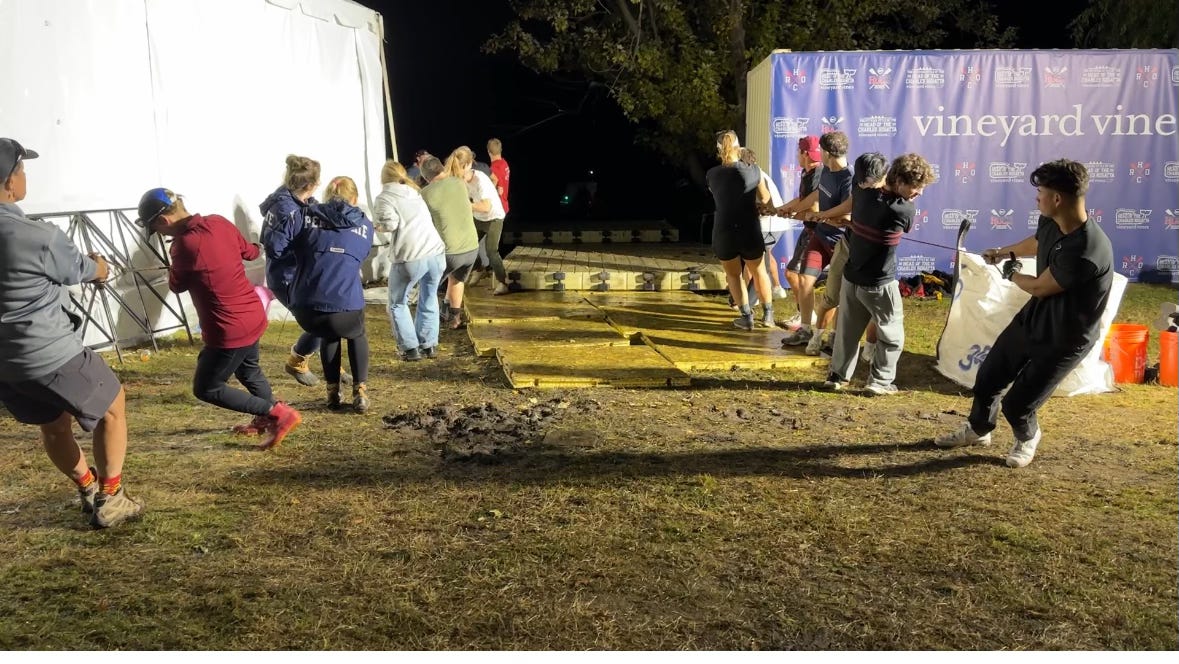Taking the docks apart
or, how to defeat entropy at the Head of the Charles
In the fifteen-plus years that I’ve volunteered for the Head of the Charles Regatta (HOCR), I’ve always worked on the docks in some capacity or another. (Which sounds so much more longshoreman-like and rough and tumble than it really is.) At the docks, you help the athletes launch to head down to the start line, and you “catch” them when they’re landing after they’ve crossed the finish. You see them full of hope—or fear—and then you welcome them back, when they are sometimes despondent over a race that went bad, or shivering from the HOCR’s often-fickle weather, or even delirious with joy when their coach runs to greet them with news that they’ve won a medal. You see the range of human emotions. The trepidation, the exhilaration, the community. And, working at Docks, you are part of a community too. Over 200 volunteers staff the docks over the course of the regatta’s three days, along with over 50 more who staff a critical set of docks down near the start line.
As the regatta’s third day of racing comes to a close (even before racing comes to a close, actually) the Dock Logistics volunteers begin to take the things apart. It begins with a handful of people who start dismantling the larger docks that are 80 or so feet long, taking away a section at a time as fewer and fewer boats will need them to land.
What happens then has always struck me as at once amazing, goofy, and almost swashbuckling. A guy named Rob pushes the sections of dock downstream, so that they can be piled onto the river bank where they will be collected by the companies that do the heavy deliveries for the regatta. Because the last boats are still racing down the course, Rob has to go slowly with his launch (the opposite of a tugboat, it becomes a kind of pushboat). It’s a stately procession, something like what Philip Sydney describes in an 18th-century poem about Elizabeth I’s barge going down the Thames.
So that’s a bit of entropy for you. What was assembled ten or so days before the regatta comes inevitably apart, piece by piece. It breaks apart—like even the strongest, fastest rowers who are, inevitably, dead tired once they’ve spent every bit of energy they had for the competition.
But that’s where things change, and the Head of the Charles, with all its complicated and sometimes fraught beauty, defies the world’s steady decline from plenty to little.
I said, casually, that the sections of dock are collected. That word leaves out so much. Because you can’t “collect” sections of molded plastic dock that are—each—about 10’ x 10’ in size and weigh goodness knows how much (even when they’re not, as one or two always are, full of water) without a lot of work. Which comes from the three or four college rowing teams who sign up every year to do this work in exchange for an entry in the following year’s regatta. These kids show up at the end of a very long weekend, having themselves raced (quite possibly just hours prior), and begin a highly organized but elaborate process of:
attaching handled long ropes to the corners of the dock as it’s butting up against the shore
grabbing handles and bracing themselves in the mud (there is always mud)
and on someone’s call (a leader always emerges), pulling and running to haul the dock, forty feet at a time, up onto the shore
taking power-drivers to the screws to take the sections apart
jumping up and down to free the unscrewed sections from each other
carrying the sections and piling them up in growing stacks
These kids are college teammates, but they don’t know the kids on the other teams who’re volunteering any given year. At least, not when they start this job. But as the hours (oh, yes, it takes hours) go on, they become members of a new team, and they keep at it, together, despite the cold and fatigue and, yes, the mud.
The docks come apart. The regatta unwinds. Section by long section, Rob pushes the docks onto shore while these forty or so college kids haul ropes like they were born to it. The sun goes down. Racing is done. Any spectators and rowers who had lingered at the large finish-area venue go home. But these kids are still there, busy building something, even as they take the docks apart.
I am sucker for a team. Which is why my life as a writer has been rich with writing groups and workshops and, now, a publishing company through which I can champion other writers—and do that while working with our own small Galiot Press team. To see a beloved event come to an end, and come apart, is always sad. Even if it means a relief from hard training and a hard weekend of racing, the ending can be tough. There’s also the sneaky intrusion of regrets: could you have gone faster? pushed harder? steered a better course? was there a friend you wanted to meet but couldn’t find and now won’t see until next year? But if you want to find some beauty in the loss, just watch the process of the docks coming apart and the teams coming together. It’ll make you feel like you’ve defied the laws of physics.





Thanks Henrietta. It's always an incredible experience. Every year is different yet the same as it comes together and gets done.
From the guy named Rob in the story above. Thank you! This is something people should take the time to read. It’s something so joyful and life altering when it happens. People growing in front of your eyes. Leaders growing and becoming their true selves through tough times they push on.